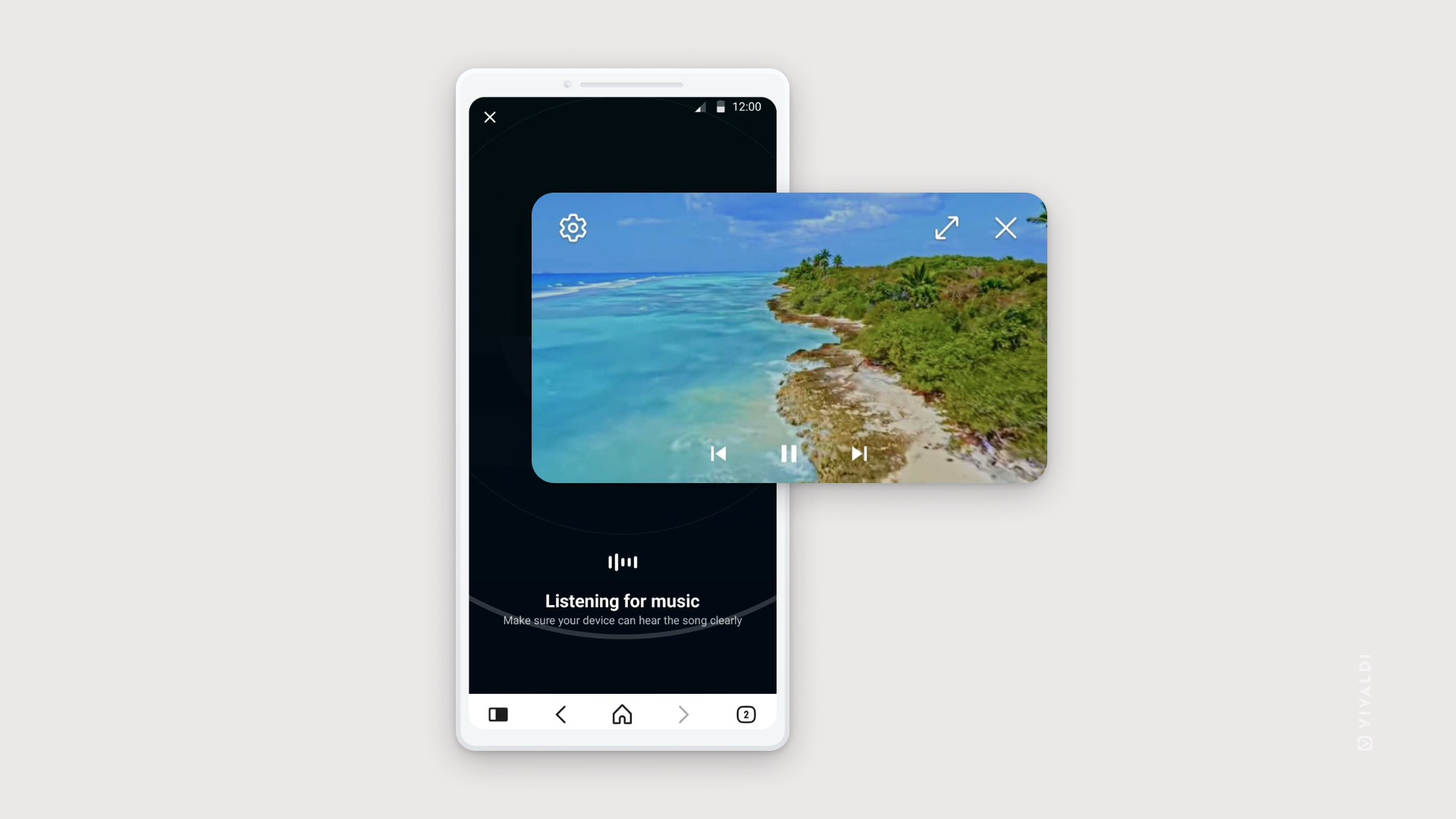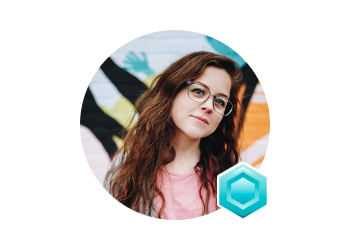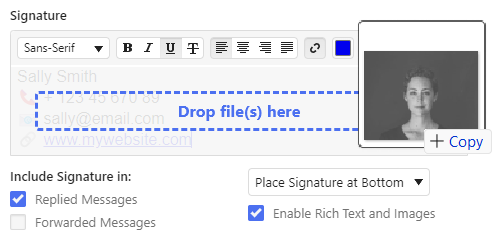Tabs on Android
Managing all your tabs in the mobile version of Vivaldi is as easy and efficient as on desktop.
Tab Switcher
To view your Tabs in the Tab Switcher, either:
- Tap on the Tab Switcher button on the right side of the bottom toolbar.
- Swipe down from the Address Bar.
The number in the Tab Switcher button indicates, how many open Tabs and Tab Stacks you have.
Slide left to view Private Tabs, Tab Stacks, Synced Tabs, and Recently Closed Tabs.
The active tab will be displayed with a border around the Tab thumbnail. Tap on the thumbnail to switch to the selected Tab.
To search for an open tab:
- Tap on the
 Search button in the top right corner of the Tab Switcher.
Search button in the top right corner of the Tab Switcher. - Start typing the tab’s name or link to find matching results.
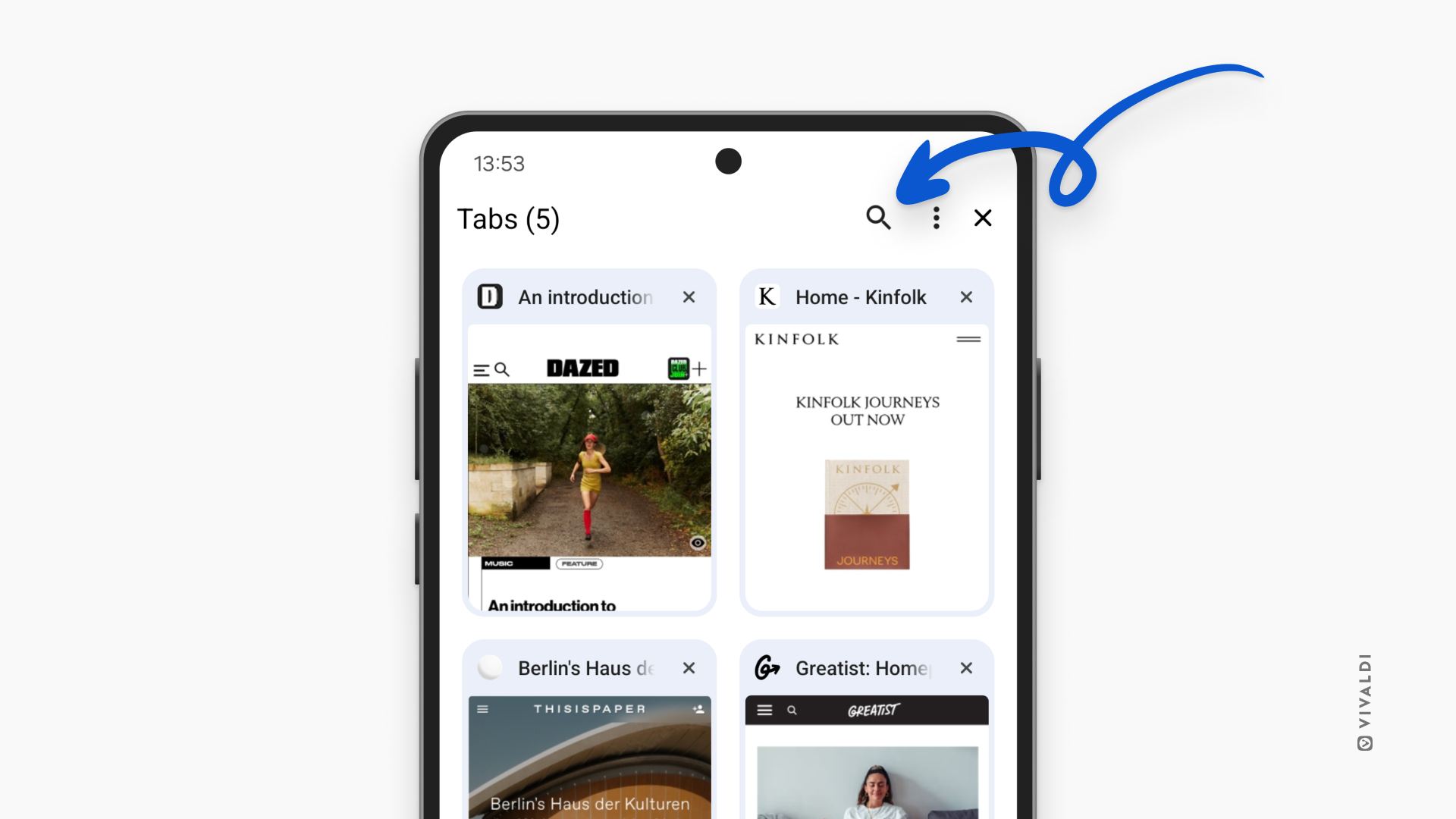
Tab Bar
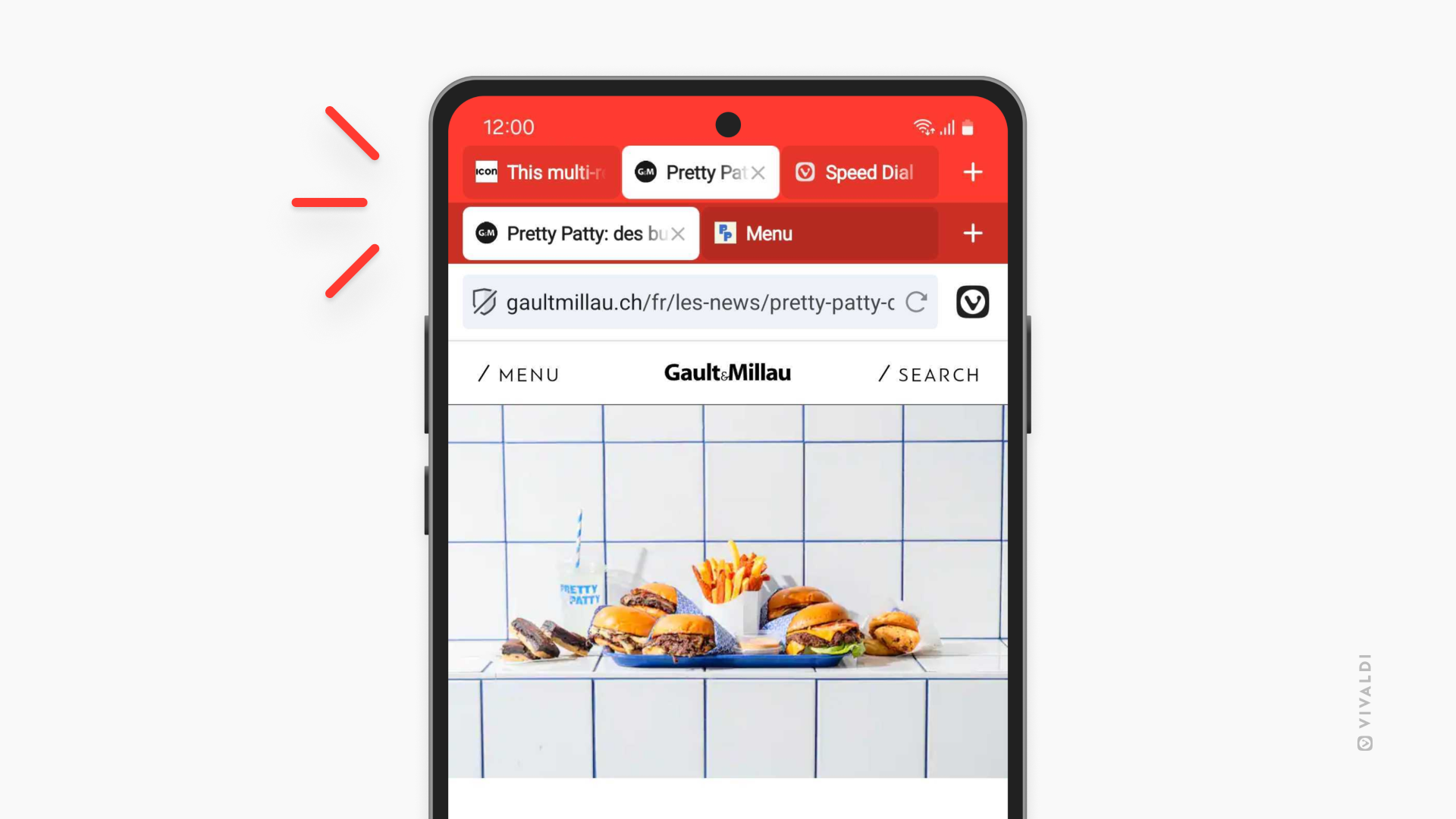
Vivaldi Android comes with a Tab Bar known from the desktop browser. To enable/disable the Tab Bar:
- Go to the
 Vivaldi menu > Settings > Tabs;
Vivaldi menu > Settings > Tabs; - Tap on Show Tab Bar to toggle the setting on or off.
Show Close button for background tabs
By default the close button is shown only for the active tab. In case you’d like to be able to quickly close background tabs:
- Go to the
 Vivaldi menu > Settings > Tabs;
Vivaldi menu > Settings > Tabs; - Tap on Show X Button For Background Tabs to toggle the setting on or off.
It’s better to keep the setting disabled, if you find yourself tapping the wrong spot on the screen and accidentally closing tabs.
Show Tab as Favicon
In case you want to squeeze as many tabs on the Tab Bar as possible, you can opt for only showing the pages favicon without the page title on the Tab Bar. To do that:
- Go to the
 Vivaldi menu > Settings > Tabs;
Vivaldi menu > Settings > Tabs; - Tap on Show Tab as Favicon to toggle the setting on or off.
Minimum Tab Width
To increase the width of tabs on the Tab Bar:
- Go to Settings > Tabs > Minimum Tab Width.
- Use the slider to set a preferred size for the tabs.
Open Tabs
Option 1
- Open the
 Vivaldi menu on the right side of the Address Bar;
Vivaldi menu on the right side of the Address Bar; - Select New Tab.
Option 2
- Open the Tab Switcher;
- Tap on the + button in the bottom right corner.
Option 3
- In the Tab Switcher, tap on the
 overflow menu in the bottom right corner;
overflow menu in the bottom right corner; - Tap New tab.
Option 4
- While viewing a web page or the Speed Dial, long-press on the Tab Switcher button until a context menu opens;
- Select New tab or New private tab.
Option 5
In case you have enabled the Tab Bar from ![]() Vivaldi menu > Settings > Tabs, tap on the
Vivaldi menu > Settings > Tabs, tap on the ![]() New tab button on the right side of the Tab Bar.
New tab button on the right side of the Tab Bar.
Option 6
When Vivaldi isn’t open:
- Long press on the app button on your home screen or app launcher until a context menu opens;
- Select New tab or Private tab.
New Tab Position
Similarly to Vivaldi on desktop, you can decide where the new tab opens. Go to ![]() Vivaldi menu >Settings > Tabs > New Tab Position and choose between:
Vivaldi menu >Settings > Tabs > New Tab Position and choose between:
- After Related Tabs: The new tabs will share a “parent-child” relationship – if you open a link in your current tab, the new tab will open next to its “parent”;
- After Active Tab: Opens new tab next to the current active tab (this is the default);
- As Last Tab: Opens new tab at the end of the tabs;
- As Tab Stack With Related Tab: Opens a new tab stack with the active tab and the new tab.
New Tab Page
By default a new tab opens with the Start Page that has your favorite Bookmarks displayed on the Speed Dial. To open a new tab with a specific website:
- Go to
 Vivaldi Menu > Settings > Homepage.
Vivaldi Menu > Settings > Homepage. - Toggle the setting On.
- Select Enter custom web address.
- Type or paste the link.
- Exit settings.
The setting will also apply when tapping the ![]() Home button.
Home button.
Automatically focus Address Field in a new tab.
Usually a new tab is opened to navigate to a new site or to Search. Both actions commonly require the use of the Address Bar. To skip the step of tapping on the Address Bar to focus on it before you can type the link or search term, the Address Field is focused automatically whenever you open a new tab. If you don’t like that behavior you can disable Focus Address Bar on New Tab from ![]() Vivaldi menu >Settings > Tabs.
Vivaldi menu >Settings > Tabs.
Open links in new tabs
To open a link on a website in a new tab:
- Long-press on the link;
- From the context menu select:
- Open in new tab,
- Open in new Tab Stack (enable stacks from
 Vivaldi menu >Settings > Tabs),
Vivaldi menu >Settings > Tabs), - Open in new background tab,
- Open in private tab.
Reload Tabs
To reload the web page you have open in the active tab use one of the following options:
- Tap on the
 Reload button on the Address Bar.
Reload button on the Address Bar. - Scroll to the top and drag the page down. When you see the
 reload icon, release your finger to reload the page.
reload icon, release your finger to reload the page. - Open the Vivaldi menu and select
 Reload.
Reload. - Tap on the Address Bar and tap Go on the keyboard.
Switch Tabs
Option 1
Swipe left or right, while your finger is placed either on the Address Bar or bottom toolbar to go to the next or previous tab.
Option 2
- Open the Tab Switcher;
- Tap on the tab thumbnail you want to open.
Option 3
In case you have enabled the Tab Bar from ![]() Vivaldi menu > Settings > Tabs, switch tabs by tapping on the tab on the Tab Bar.
Vivaldi menu > Settings > Tabs, switch tabs by tapping on the tab on the Tab Bar.
Close Tabs
Option 1
- Open the Tab Switcher;
- Tap on the Close button in the top right corner of the Tab thumbnail you’d like to close.
Option 2
- While viewing a web page or the Speed Dial, long-press on the Tab Switcher button until a context menu opens;
- Select Close tab.
Option 3
- Enable Swipe to Close Tab in Settings;
- In the Tab Switcher, swipe left or right to close a Tab.
Please note that enabling Swipe to Close Tab, will disable swiping between panels in the Tab Switcher.
Close all Tabs
- Open the Tab Switcher;
- Tap on the overflow menu on the right side of the bottom toolbar at the bottom of the screen.
- Tap Close All Tabs.
Inactive Tabs
Tabs you haven’t viewed in a while will appear in the Inactive Tabs section at the top of the Tab Switcher, allowing you to review and make a call on whether you want to keep the tabs open or whether they can be closed.
Automatically close inactive Tabs
If you have a tendency to open more and more new tabs, but hardly ever close any of the tabs, then eventually you’ll end up with so many tabs that closing them one by one will take a long time. Plus, a large number of tabs may start affecting performance and battery life.
In Vivaldi for Android, you have an option to close all inactive tabs in one move. To set it up:
- Go to
 Vivaldi menu > Settings > Tabs > Automatically Close Tabs.
Vivaldi menu > Settings > Tabs > Automatically Close Tabs. - Select after what time period the tabs are considered inactive and you’ll be prompted to close them if you have more than 20 inactive tabs. You can choose between:
- Never,
- One Week,
- One Month, and
- Three Months.
If you don’t want to close inactive tabs, make sure Never is the selected option.
If you don’t want to wait for a prompt to close inactive tabs, go to Automatically Close Tabs settings and if there are any inactive tabs, you can tap the button Close Inactive Tabs.
Recently Closed Tabs
To open a recently closed Tab:
- Open the Tab Switcher;
- Swipe to Recently Closed Tabs or tap the
 Closed Tabs icon;
Closed Tabs icon; - Tap on the entry you wish to reopen.
Reorder Tabs
To change the order of your open Tabs in the Tab Switcher:
- Long press on a Tab;
- Drag and drop the tab to its new location.
In case you have enabled the Tab Bar from ![]() Vivaldi menu > Settings > Tabs, long-press on the tab on the Tab Bar and drag to reorder the tabs.
Vivaldi menu > Settings > Tabs, long-press on the tab on the Tab Bar and drag to reorder the tabs.
Duplicate Tabs
To create an exact copy of your current active tab (including its history), open the ![]() Vivaldi menu and select Duplicate Tab.
Vivaldi menu and select Duplicate Tab.
Sync Tabs
In the third tab in the Tab Switcher, all the tabs you have open on your other devices – Remote Sessions – that you’ve Synced with the same Vivaldi account will be listed.
When you open a tab from Synced Tabs, it will be opened locally and listed with your other Tabs.
To learn more about syncing Remote Sessions, have a look at our help pages about Sync on Mobile and Sync on Desktop.
Private Tabs
When you browse using a Private Tab, Vivaldi will minimise what is stored locally on your phone so that very few traces are left of what you were browsing once you close all private browsing tabs.
Open private tabs
Option 1
- Open the
 Vivaldi menu on the right side of the Address Bar;
Vivaldi menu on the right side of the Address Bar; - Select New Private Tab.
Option 2
- Open the Tab Switcher;
- Slide to Private Tabs;
- Tap on the + button in the middle of the bottom toolbar.
Option 3
- In the Tab Switcher, tap on the overflow menu on the right side of the bottom toolbar.
- Tap New Private Tab.
Close Private Tabs
- Open the Tab Switcher;
- Tap on the Close button in the top right corner of the Tab thumbnail.
Close all Private Tabs
Option 1
- Open the Tab Switcher;
- tap on the overflow menu on the right side of the bottom toolbar.
- Tap Close Private Tabs.
Option 2
- Open the phone’s notification menu by sliding down from the top of the screen;
- Tap on Vivaldi – Close all private tabs.
Lock Private Tabs
When you leave Private Tabs open for longer, you can lock them. Next time you open Vivaldi and wish to view a private tab, you’ll be first asked for your phone’s or tablet’s screen lock (PIN, password, pattern, etc.).
To enable or disable locking of Private Tabs:
- Go to the
 Vivaldi menu > Settings > Privacy and Security.
Vivaldi menu > Settings > Privacy and Security. - Toggle on Lock Private tabs when you leave Vivaldi.
- Verify yourself with your device’s unlock method.
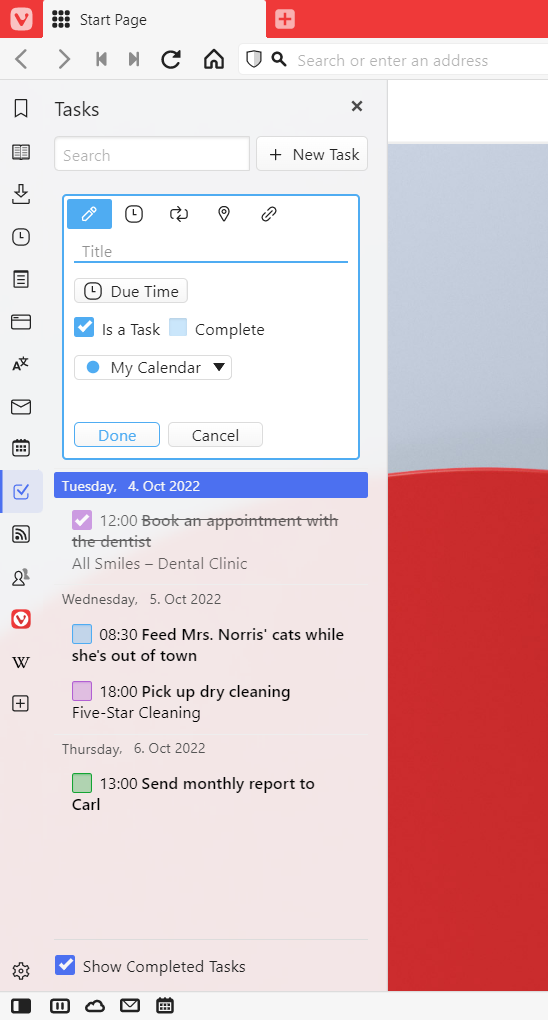
 Open in New Tab button in the top right corner of the preview.
Open in New Tab button in the top right corner of the preview.  Close button or swipe down on the preview.
Close button or swipe down on the preview.


 , not secure
, not secure  or even dangerous
or even dangerous  .
.

